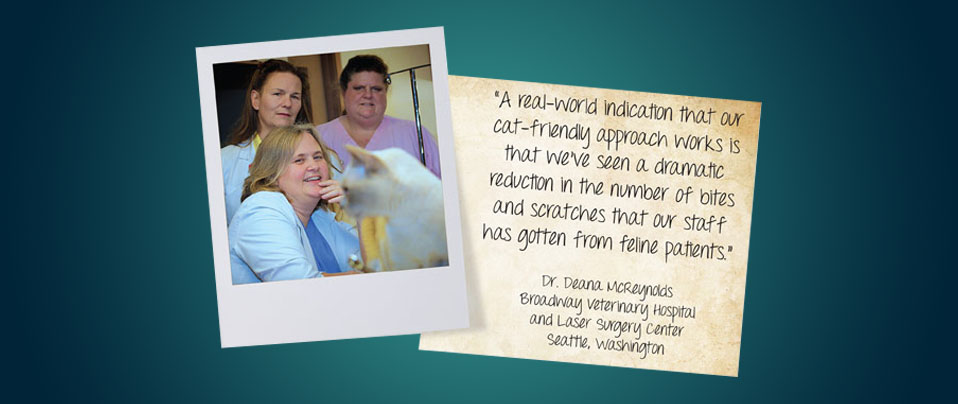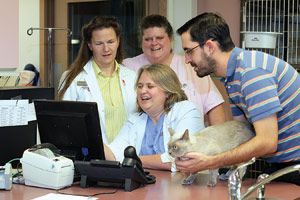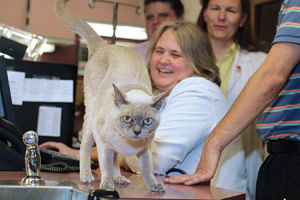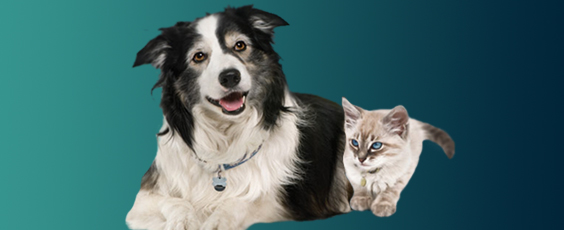Feline-Friendly Practice Tools from Partners for Healthy Pets and the AAFP

Fewer Bites and Scratches! Just One Benefit of Being a Cat-Friendly Practice
Tips for Creating a Cat Friendly Practice
Dr. Deana McReynolds led the initiative at the Broadway Veterinary Hospital and Laser Surgery Center in Seattle, Washington to become an AAFP-certified Cat Friendly Practice (CFP). She offers several tips for handling feline patients in a cat-friendly manner, from the reception area to educating clients at the end of the exam:
- Visit the Partners for Healthy Pets web site, “Feline Friendly Practice” Resources Toolbox page and spend some time exploring.
- Avoid putting cats and dogs in the same room. Establish a cats-only section of the reception area so that feline patients will avoid proximity to dogs, which tend to be energetic and loud. Placing a towel over the cat’s carrier in the reception area can shield it from the view of other animals.
- Bring cats to the exam room as soon as possible after arrival. This avoids fear-escalation that can result when a newly arriving cat encounters other animals in the reception area. Give cats 10 to 15 minutes prior the exam to become acquainted with its surroundings.
- Conduct all procedures (patient history, obtaining vital signs, the physical exam itself, treatment, and client discussion) in the same room whenever possible. This avoids subjecting the feline patient to the stress of moving it to several areas of the clinic.
- Use a stuffed animal to train staff in gentle feline restraint methods, for example when practicing wrapping a cat in a towel to simultaneously provide security and facilitate the physical exam.
- Avoid exposing cats to strange smells. Clean the exam room with a scent-neutral agent after each patient leaves to prevent exposing incoming cats to odors from dogs and other feline patients.
- Use synthetic pheromones to reduce anxiety in feline patients. Wrapping a cat in a towel treated with a commercial pheromone spray often has a calming effect.
- A cat-friendly approach is mostly about preventing a cat’s anxiety level from escalating to fear and aggression, and less about the way the cat is physically handled.
- An excellent multi-media reference is Dr. Sophia Yin’s book Low Stress Handling, Restraint and Behavior Modification of Dogs and Cats: Techniques for Developing Patients Who Love Their Visits.
Dr. Deana McReynolds was convinced that by becoming a cat friendly practice (CFP) the Broadway Veterinary Hospital (BVH) and Laser Surgery Center in Seattle, Washington would attract regular visits from often skeptical cat-owner clients. “We become the first CFP-certified hospital in Seattle and one of the first in the nation,” she says. “As a result, our staff has become skilled in cat-friendly handling techniques, and we provide a welcoming, low-stress environment for our feline patients,” she says.
BVH Healthcare Team

Cat owners have responded very favorably to the BVH healthcare team’s expertise and empathetic manner with cats. “The clients get it,” Dr. McReynolds says. “We’ve gotten a lot of positive feedback. Cat owners now tell us how much they appreciate the way we work with their animals and how different our approach is from what they experienced in the past.
“An angry or fearful cat will be aggressive. A real-world indication that our cat-friendly approach works is that we’ve seen a dramatic reduction in the number of bites and scratches that our staff has gotten from feline patients. When the client sees that the cat is calm and manageable in the hands of our healthcare team, they realize that our methods result in a better exam experience.”
How to get started
The Resources Toolbox on the Partners for Healthy Pets web site has a “Feline Friendly Practice” tools page that the Dr. McReynolds found to be particularly useful for staff training purposes. “The Partners Toolbox is an excellent starting point for any veterinarian, including non-AAFP members, seeking to become more knowledgeable and skilled in handling feline patients,” she says. “The Partners site is a one-stop location for resources on how to make a practice more accommodating to cats. For example, our staff was very excited and motivated by the six short videos developed by the CATalyst Council on practical, cat-friendly handling techniques.”
The training videos are accessible on the Partners web site and include topics such as handling and calming a fearful cat, how to make cat carriers ‘friends’ instead of ‘foes’, and how to obtain a lab sample from a cat. Other resources available at the Partners Feline Friendly web page include:
- Direct links to the AAFP web site to begin the CFP certification process.
- A 60-minute web conference on the clinical and business rationale for becoming a CFP.
- A 60-minute web conference on AAFP feline-friendly handling guidelines.
- “Pouncing on Opportunity,” a practical Trends magazine article about how several veterinary practices are benefiting from being cat-friendly.
CFP certification is awarded by the American Association of Feline Practitioners (AAFP) to practices that meet 10 specific criteria designed to serve the unique needs of feline patients. A practice can qualify for silver and gold levels of CPF certification. The process is completed online at the AAFP web site (catvets.com).
How cat-friendly wins clients
Although the estimated U.S. pet cat population exceeds the number of pet dogs by several million,1 a recent survey found that 40% of pet cats have not been to a veterinarian in the past year versus only 15% of dogs.2 A low ratio of cat-to-dog visits is a strong indication that a companion animal practice has an underserved feline patient population. The recent Bayer Veterinary Care Usage Study confirmed that “feline resistance” was one of six key factors in a decade-long decline in utilization of veterinary medical services.2 Survey results indicate that nearly four in 10 cat owners would take their animal to see a veterinarian only if it was sick. The trend toward fewer patient visits has occurred despite a robust increase in dog and cat ownership in the U.S.
“A cat is usually put in its carrier for one purpose,” Dr. McReynolds explains, “and that is to be taken to the veterinarian. The cat knows something is up and that it’s not going to be fun. Its natural reaction is to aggressively resist being put in a carrier and to show signs of stress during exams.”
The Bayer study found that nearly four in 10 cat owners reported that they “get stressed just thinking about” taking their cats to the veterinarian, and 58% say their cat “hates going to the vet”. It is clear that overcoming feline resistance in the exam setting can unlock a major source of client visits and greatly expand healthcare delivery to pet cats. “Becoming a Cat Friendly Practice helped us do that,” Dr. McReynolds says. “It allows our practice to provide higher quality of care for feline patients.”
She explains that cats have environmental needs and behavioral characteristics that are very different from a dog’s.3,4 Besides being quite susceptible to stress and anxiety, cats do not like being placed in unfamiliar environments. They prefer solitude and quiet, use space as a means of security, and are highly sensitive to unusual sights, sounds, and smells. “Cats respond to gentle handling and being approached gradually,” Dr. McReynolds says. “They don’t like sudden encroachment by people or heavy handed methods such as being grabbed by the scruff. Momma cats can do that with their kittens but when we do it, all of a sudden you have an angry cat. Proper handling, restraint, and exam technique are important cat-friendly skills that our entire clinical staff uses.”
Becoming a cat friendly practice
The “Feline Friendly Practice” tools page on the Partners for Healthy Pets web site is designed to provide an introductory overview of the cat-friendly practice concept as well as a menu of resources to help the entire practice team develop the skills to become more “feline friendly”. These include in-depth web conferences by leading feline practitioners who offer insights and practical suggestions based on decades of experience. The “Feline Friendly Practice” web page also has tabs that provide direct links to the AAFP and CATalyst web sites.
Practices that aspire to become a CFP certified must have at least one AAFP member. The AAFP web site has complete information on the CFP certification process. While a formal certification process may not be for all practices, certainly every practice team member can benefit by improving their feline-friendly expertise. Materials in the AAFP program include publications and videos on the 10 CFP topic areas, including staff training, modifying the clinic environment to accommodate feline patients, proper cat handling techniques, treatment recommendations, and preventive care at each feline life stage. The AAFP site provides its own suite of resource materials, including online brochures that explain the benefits of CFP certification for veterinarians and cat owners.
Involving the healthcare team

A certified CFP must have at least one designated Cat Advocate on staff. Dr. McReynolds led the initiative in 2012 to obtain CFP certification at BVH and has a strong interest in animal behavior. She is the practice’s Cat Advocate and resident expert on feline care. A BVH technician serves as her CFP co-advocate. Dr. McReynolds emphasizes that the entire BVH healthcare team is invested in being a Cat Friendly Practice (CFP).
“It’s not sufficient if only one or two staff members are cat-friendly,” she says. “All our team members participated in Cat Friendly Practice training. We gain credibility with our clients when every staff member plays a part in implementing our cat-friendly approach. The receptionist, for example, does not have an incidental role. She makes sure that clients know that we’re a Cat Friendly Practice, that the cat carrier is covered for privacy, and that dogs and cats are well separated from each other in the waiting area. Our technician and patient advocate have important responsibilities for client education and follow-up after the exam.”
Staff training was an important part of the CFP certification process. BVH clinical personnel all had unpleasant past experiences with hard-to-handle cats, and some were skeptical that cat-friendly methods would consistently work. “After being trained in cat-friendly awareness and handling methods, our entire staff gained new respect for cats and their owners,” Dr. McReynolds comments. “We now have a high level of confidence in our cat-friendly skills and the level of service we offer our feline patients.”
Involving the client
Because cats have species-specific needs, characteristics, and medical risk factors, client education plays a critical role in implementing a feline healthcare plan. Cat owners should be informed about environmental enrichment in the home. This includes providing elevated sites where cats can perch and find security, places where cats can hide, and multiple food sources that allow cats to simulate hunting behavior. Client perceptions of feline behavior are often based on myth more than fact, including the misconception that cats are self-sufficient and require less medical care than canine pets. Cat owners should be advised of the warning signs of medical or behavioral problems, such as inappetance, inappropriate elimination, changes in interaction, weight loss or gain, vocalization, or bad breath. Regular dialog with cat-owner clients is an important step toward scheduling regular wellness visits, ensuring compliance with healthcare recommendations, and creating a strong veterinarian-client-pet relationship.
Cat Friendly Practice
Broadway Veterinary Hospital (BVH) displays the AAFP Cat Friendly Practice logo on every page of its web site (www.broadwayvh.com) as a welcoming sign for cat owners. The BVH site also has a stand-alone “Feline Friendly” page with useful links to other sites that provide information on feline pet healthcare.
Marketing CFP certification
BVH uses its CFP certification to help market the practice and promote its expertise in feline healthcare, including the following initiatives:
- The eye-catching AAFP-CFP logo (see illustration) on every page of the BVH web site, and the site has a separate “Feline Friendly” web page.
- Visitors to the BVH Feline Friendly web page have direct access to other Internet resources of interest, including the AAFP and CATalyst web sites.
- A two-minute, animated video and an online brochure discuss how to get an unwilling cat into its carrier and low-stress ways to transport a cat to the veterinarian.
- Dr. McReynolds established a cooperative relationship with a nearby pet grooming service that specializes in cats and provides vented, scent-neutral grooming stations.
Dr. McReynolds is quick to point out that these initiatives complement the most credible type of promotion within the community, “word-of-mouth recommendations from loyal clients.”
Taking the next step
“A lot of veterinary practices know they should be cat-friendly, but for whatever reason they don’t do it,” Deana McReynolds says. “We took that step because we have great respect for cats and the role they play in our clients’ lives. They present a different kind of clinical challenge. I’m pleased that Partners for Healthy Pets and the AAFP have put cat-friendly skills within the reach of every companion animal veterinarian. This expertise has made a tangible difference in our practice.”
References
- American Veterinary Medical Association. U.S. pet ownership statistics. 2012 U.S. Pet Ownership and Demographics Sourcebook. Available at: https://www.avma.org/KB/Resources/Statistics/Pages/Market-research-statistics-US-pet-ownership.aspx. Accessed: October 15, 2013.
- Volk JO, Felsted KE, Thomas JG, Siren CW. Executive summary of the Bayer veterinary care usage study. J Am Vet Med Assoc. 2011;238:1275-1282.
- Overall KL, Rodan I, Beaver BV, et al. Feline behavior guidelines from the American Association of Feline Practitioners. Available at: http://www.catvets.com/public/PDFs/PracticeGuidelines/FelineBehaviorGLS.pdf . Accessed October 16, 2013.
- Ellis SL, Rodan I, Carney HC, et al. AAFP and ISFM feline environmental needs guidelines. J Feline Med Surg. 2013;15:219-230.
Tools of Interest
The following tools helped this hospital:
Read what your colleagues are saying about their experiences using specific Partners for Healthy Pets tools.
Success Stories are testimonial case studies of the benefits realized by patients and practices as a result of utilizing the Resources Toolbox!

